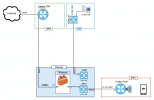Hallo zusammen,
meine alte FW droht den Geist aufzugeben und ich möchte sie gerne gegen eine virtualisierte OPNsense + Pihole ersetzen.
Dazu habe ich parallel eine Proxmox (Qotom-Q355G4 Core i5-5200U) aufgebaut und auf Port 4 über vmbr0 in das bestehende Netz integriert. Die OPNsense habe ich über PCI Passthrough auf Port 1 direkt an der Fritzbox angeschlossen.
In der Kombination kann ich von meinem Management-PC (10.168.1.90) über 10.168.1.5 auf die Proxmox zugreifen und über 172.16.1.27 auf die OPNsense.
Sobald ich allerdings vmbr1 aktiviere, kann ich zwar die Proxmox noch erreichen, nicht aber die OPNsense. Was mache ich falsch?
Ich hatte gedacht, dass die vmbr1 - aufgrund dessen, dass sie nicht ans restliche Netz angeschlossen ist - keine Wirkung haben sollte. Ist das falsch?




meine alte FW droht den Geist aufzugeben und ich möchte sie gerne gegen eine virtualisierte OPNsense + Pihole ersetzen.
Dazu habe ich parallel eine Proxmox (Qotom-Q355G4 Core i5-5200U) aufgebaut und auf Port 4 über vmbr0 in das bestehende Netz integriert. Die OPNsense habe ich über PCI Passthrough auf Port 1 direkt an der Fritzbox angeschlossen.
In der Kombination kann ich von meinem Management-PC (10.168.1.90) über 10.168.1.5 auf die Proxmox zugreifen und über 172.16.1.27 auf die OPNsense.
Sobald ich allerdings vmbr1 aktiviere, kann ich zwar die Proxmox noch erreichen, nicht aber die OPNsense. Was mache ich falsch?
Ich hatte gedacht, dass die vmbr1 - aufgrund dessen, dass sie nicht ans restliche Netz angeschlossen ist - keine Wirkung haben sollte. Ist das falsch?


